航海英语学习方法介绍
- 格式:docx
- 大小:10.51 KB
- 文档页数:2
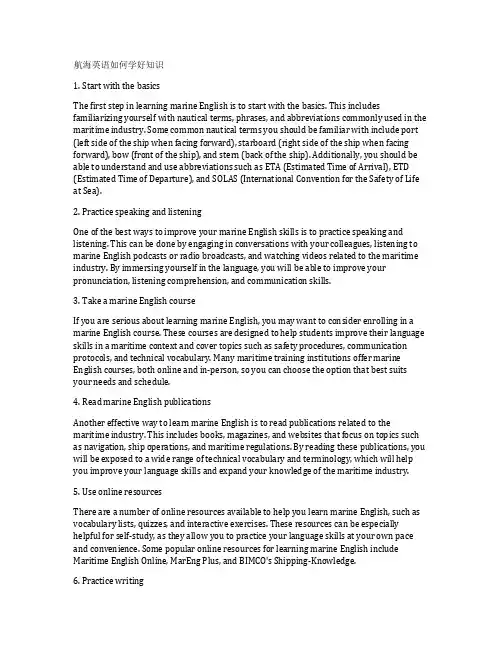
航海英语如何学好知识1. Start with the basicsThe first step in learning marine English is to start with the basics. This includes familiarizing yourself with nautical terms, phrases, and abbreviations commonly used in the maritime industry. Some common nautical terms you should be familiar with include port (left side of the ship when facing forward), starboard (right side of the ship when facing forward), bow (front of the ship), and stern (back of the ship). Additionally, you should be able to understand and use abbreviations such as ETA (Estimated Time of Arrival), ETD (Estimated Time of Departure), and SOLAS (International Convention for the Safety of Life at Sea).2. Practice speaking and listeningOne of the best ways to improve your marine English skills is to practice speaking and listening. This can be done by engaging in conversations with your colleagues, listening to marine English podcasts or radio broadcasts, and watching videos related to the maritime industry. By immersing yourself in the language, you will be able to improve your pronunciation, listening comprehension, and communication skills.3. Take a marine English courseIf you are serious about learning marine English, you may want to consider enrolling in a marine English course. These courses are designed to help students improve their language skills in a maritime context and cover topics such as safety procedures, communication protocols, and technical vocabulary. Many maritime training institutions offer marine English courses, both online and in-person, so you can choose the option that best suits your needs and schedule.4. Read marine English publicationsAnother effective way to learn marine English is to read publications related to the maritime industry. This includes books, magazines, and websites that focus on topics such as navigation, ship operations, and maritime regulations. By reading these publications, you will be exposed to a wide range of technical vocabulary and terminology, which will help you improve your language skills and expand your knowledge of the maritime industry.5. Use online resourcesThere are a number of online resources available to help you learn marine English, such as vocabulary lists, quizzes, and interactive exercises. These resources can be especially helpful for self-study, as they allow you to practice your language skills at your own pace and convenience. Some popular online resources for learning marine English include Maritime English Online, MarEng Plus, and BIMCO's Shipping-Knowledge.6. Practice writingIn addition to speaking and listening, it is important to practice writing in marine English. This can be done by writing emails, reports, or technical documents related to the maritime industry. By practicing your writing skills, you will improve your grammar, vocabulary, and communication skills, which are essential for effective communication in a maritime context.7. Seek feedbackFinally, to improve your marine English skills, it is important to seek feedback from others. This can be done by asking your colleagues, instructors, or mentors to review your language skills and provide constructive criticism. By receiving feedback, you will be able to identify areas for improvement and work on enhancing your language skills further.In conclusion, learning marine English is essential for anyone working in the maritime industry. By starting with the basics, practicing speaking and listening, taking a marine English course, reading marine English publications, using online resources, practicing writing, and seeking feedback, you can improve your language skills and excel in your maritime career. Remember that learning a new language takes time and effort, so be patient and persistent in your language learning journey. With dedication and practice, you will be able to master marine English and enhance your communication skills in the maritime industry.。
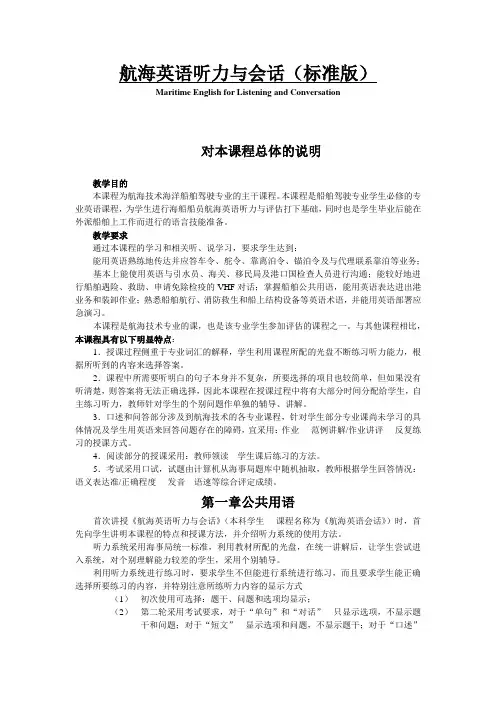
航海英语听力与会话(标准版)Maritime English for Listening and Conversation对本课程总体的说明教学目的本课程为航海技术海洋船舶驾驶专业的主干课程。
本课程是船舶驾驶专业学生必修的专业英语课程,为学生进行海船船员航海英语听力与评估打下基础,同时也是学生毕业后能在外派船舶上工作而进行的语言技能准备。
教学要求通过本课程的学习和相关听、说学习,要求学生达到:能用英语熟练地传达并应答车令、舵令、靠离泊令、锚泊令及与代理联系靠泊等业务;基本上能使用英语与引水员、海关、移民局及港口国检查人员进行沟通;能较好地进行船舶遇险、救助、申请免除检疫的VHF对话;掌握船舶公共用语,能用英语表达进出港业务和装卸作业;熟悉船舶航行、消防救生和船上结构设备等英语术语,并能用英语部署应急演习。
本课程是航海技术专业的课,也是该专业学生参加评估的课程之一。
与其他课程相比,本课程具有以下明显特点:1.授课过程侧重于专业词汇的解释,学生利用课程所配的光盘不断练习听力能力,根据所听到的内容来选择答案。
2.课程中所需要听明白的句子本身并不复杂,所要选择的项目也较简单,但如果没有听清楚,则答案将无法正确选择,因此本课程在授课过程中将有大部分时间分配给学生,自主练习听力,教师针对学生的个别问题作单独的辅导、讲解。
3.口述和问答部分涉及到航海技术的各专业课程,针对学生部分专业课尚未学习的具体情况及学生用英语来回答问题存在的障碍,宜采用:作业----范例讲解/作业讲评----反复练习的授课方式。
4.阅读部分的授课采用:教师领读---学生课后练习的方法。
5.考试采用口试,试题由计算机从海事局题库中随机抽取,教师根据学生回答情况:语义表达准/正确程度----发音---语速等综合评定成绩。
第一章公共用语首次讲授《航海英语听力与会话》(本科学生----课程名称为《航海英语会话》)时,首先向学生讲明本课程的特点和授课方法,并介绍听力系统的使用方法。

航海英语考试攻略航海英语复习注意事项1、时间计划:很多学生在复习期间管理不好自己的时间,吃饭也要成群结队,首先给自己制定一个时间计划,例如早上6点30准时到教室,中午加休息吃饭一个半小时,下午吃饭加休息一个小时,晚上到12点准时睡觉。
2、效率管理:很多学生时间是占到了,但是一会扒拉扒拉手机,一会交头接耳,题库的页数一晚上翻不了两三页,眼睛盯着题库脑子早就飞到九霄云外去了,到晚上别人回去休息了,自己也去休息了,有的可能还暗暗发狠明天一定要怎样怎样复习。
对于没有紧迫感,存在拖延症的同学需要给自己施加压力,例如今晚从六点到十一点半,看英语200道,航海学100道,从后往前看,从第200道题看到第1题,看不完就不休息。
以后循序渐进,每天多加10-20道题目。
我相信每一天三个时间段充分利用好,熟悉掌握800道题目应该是比较容易的,所以三科内容通过还是比较Easy,前提是这800道得看到脑子里呀。
3、学会休息:该休息的时候就休息,(以前听个故事说普京为什么可以一直保持如此活力?就是因为他只要感觉自己困了就会闭目睡15分钟),中午和下午的休息是绝对有必要的,如果在连续看2个小时实在是没有心情看下去了,不要强迫自己继续看,可以选择趴在桌上休息十五分钟,也可在上厕所时候拿着书看看(据统计说在厕所看东西记忆力相当好),也可出去走两圈放松一下。
4、营养:只要是做有意义的事情,花钱吃喝就不要在乎了。
航海英语考试应对策略航海英语分为:单选题76分和关联题24分(分值每题1.5分),航海英语总结其他科目的知识,学习起来比较困难。
这个没有好的方法,英语内容你必须看的明白才能记得住,重要单词重复率很高,把正确答案写在题目的最前面,不要直接把正确答案潦草的写在题目中的横线上(在记忆过程中会有依赖性,看题目就知道答案了,在考试中全是空白的),把答案写在前面的好处就是每次看就像是看到新题一样,最好也不要在题目上,把单词直接标注在每一页的上面空白部分。
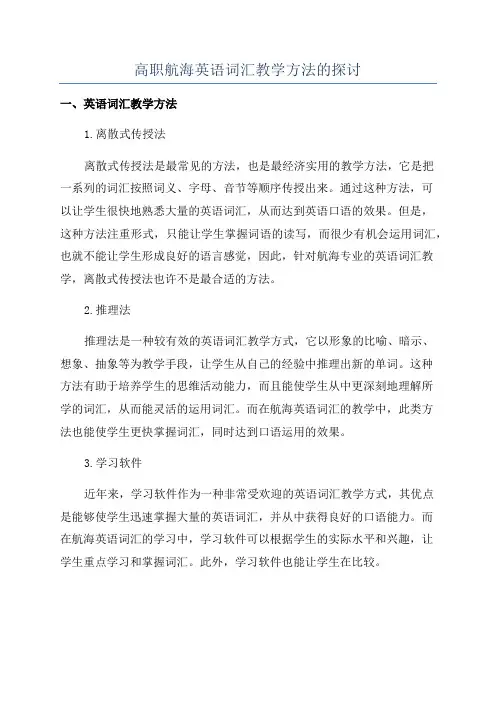
高职航海英语词汇教学方法的探讨
一、英语词汇教学方法
1.离散式传授法
离散式传授法是最常见的方法,也是最经济实用的教学方法,它是把
一系列的词汇按照词义、字母、音节等顺序传授出来。
通过这种方法,可
以让学生很快地熟悉大量的英语词汇,从而达到英语口语的效果。
但是,
这种方法注重形式,只能让学生掌握词语的读写,而很少有机会运用词汇,也就不能让学生形成良好的语言感觉,因此,针对航海专业的英语词汇教学,离散式传授法也许不是最合适的方法。
2.推理法
推理法是一种较有效的英语词汇教学方式,它以形象的比喻、暗示、
想象、抽象等为教学手段,让学生从自己的经验中推理出新的单词。
这种
方法有助于培养学生的思维活动能力,而且能使学生从中更深刻地理解所
学的词汇,从而能灵活的运用词汇。
而在航海英语词汇的教学中,此类方
法也能使学生更快掌握词汇,同时达到口语运用的效果。
3.学习软件
近年来,学习软件作为一种非常受欢迎的英语词汇教学方式,其优点
是能够使学生迅速掌握大量的英语词汇,并从中获得良好的口语能力。
而
在航海英语词汇的学习中,学习软件可以根据学生的实际水平和兴趣,让
学生重点学习和掌握词汇。
此外,学习软件也能让学生在比较。

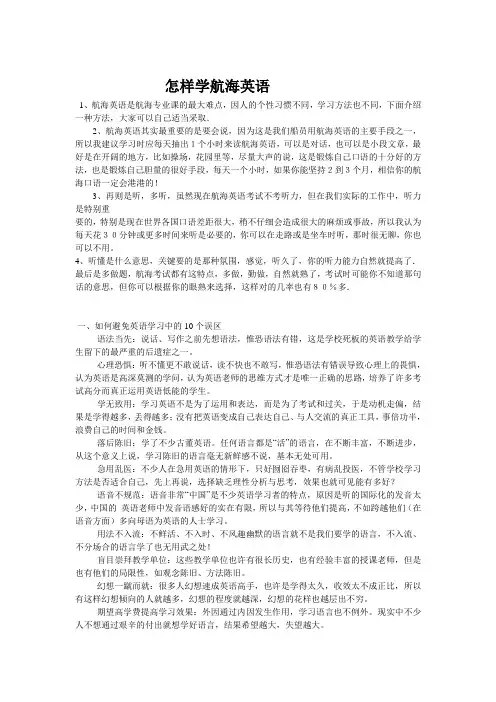
怎样学航海英语1、航海英语是航海专业课的最大难点,因人的个性习惯不同,学习方法也不同,下面介绍一种方法,大家可以自己适当采取.2、航海英语其实最重要的是要会说,因为这是我们船员用航海英语的主要手段之一,所以我建议学习时应每天抽出1个小时来读航海英语,可以是对话,也可以是小段文章,最好是在开阔的地方,比如操场,花园里等,尽量大声的说,这是锻炼自己口语的十分好的方法,也是锻炼自己胆量的很好手段,每天一个小时,如果你能坚持2到3个月,相信你的航海口语一定会港港的!3、再则是听,多听,虽然现在航海英语考试不考听力,但在我们实际的工作中,听力是特别重要的,特别是现在世界各国口语差距很大,稍不仔细会造成很大的麻烦或事故,所以我认为每天花30分钟或更多时间来听是必要的,你可以在走路或是坐车时听,那时很无聊,你也可以不用。
4、听懂是什么意思,关键要的是那种氛围,感觉,听久了,你的听力能力自然就提高了.最后是多做题,航海考试都有这特点,多做,勤做,自然就熟了,考试时可能你不知道那句话的意思,但你可以根据你的眼熟来选择,这样对的几率也有80%多.一、如何避免英语学习中的10个误区语法当先:说话、写作之前先想语法,惟恐语法有错,这是学校死板的英语教学给学生留下的最严重的后遗症之一。
心理恐惧:听不懂更不敢说话,读不快也不敢写,惟恐语法有错误导致心理上的畏惧,认为英语是高深莫测的学问,认为英语老师的思维方式才是唯一正确的思路,培养了许多考试高分而真正运用英语低能的学生。
学无致用:学习英语不是为了运用和表达,而是为了考试和过关,于是动机走偏,结果是学得越多,丢得越多;没有把英语变成自己表达自己、与人交流的真正工具,事倍功半,浪费自己的时间和金钱。
落后陈旧:学了不少古董英语。
任何语言都是“活”的语言,在不断丰富,不断进步,从这个意义上说,学习陈旧的语言毫无新鲜感不说,基本无处可用。
急用乱医:不少人在急用英语的情形下,只好囫囵吞枣,有病乱投医,不管学校学习方法是否适合自己,先上再说,选择缺乏理性分析与思考,效果也就可见能有多好?语音不规范:语音非常“中国”是不少英语学习者的特点,原因是听的国际化的发音太少,中国的英语老师中发音语感好的实在有限,所以与其等待他们提高,不如跨越他们(在语音方面)多向母语为英语的人士学习。
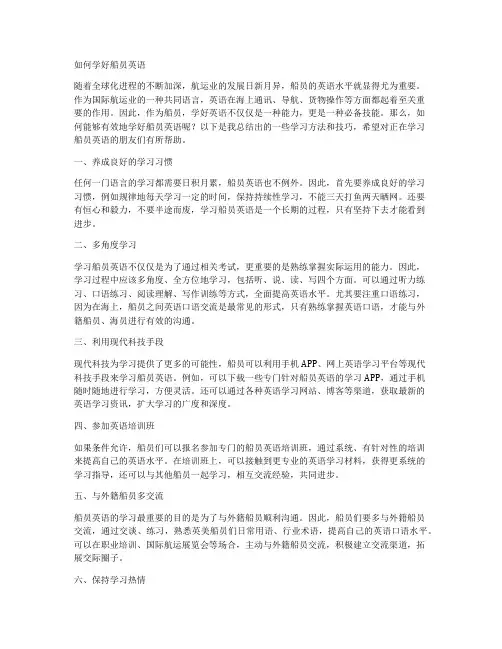
如何学好船员英语随着全球化进程的不断加深,航运业的发展日新月异,船员的英语水平就显得尤为重要。
作为国际航运业的一种共同语言,英语在海上通讯、导航、货物操作等方面都起着至关重要的作用。
因此,作为船员,学好英语不仅仅是一种能力,更是一种必备技能。
那么,如何能够有效地学好船员英语呢?以下是我总结出的一些学习方法和技巧,希望对正在学习船员英语的朋友们有所帮助。
一、养成良好的学习习惯任何一门语言的学习都需要日积月累,船员英语也不例外。
因此,首先要养成良好的学习习惯,例如规律地每天学习一定的时间,保持持续性学习,不能三天打鱼两天晒网。
还要有恒心和毅力,不要半途而废,学习船员英语是一个长期的过程,只有坚持下去才能看到进步。
二、多角度学习学习船员英语不仅仅是为了通过相关考试,更重要的是熟练掌握实际运用的能力。
因此,学习过程中应该多角度、全方位地学习,包括听、说、读、写四个方面。
可以通过听力练习、口语练习、阅读理解、写作训练等方式,全面提高英语水平。
尤其要注重口语练习,因为在海上,船员之间英语口语交流是最常见的形式,只有熟练掌握英语口语,才能与外籍船员、海员进行有效的沟通。
三、利用现代科技手段现代科技为学习提供了更多的可能性,船员可以利用手机APP、网上英语学习平台等现代科技手段来学习船员英语。
例如,可以下载一些专门针对船员英语的学习APP,通过手机随时随地进行学习,方便灵活。
还可以通过各种英语学习网站、博客等渠道,获取最新的英语学习资讯,扩大学习的广度和深度。
四、参加英语培训班如果条件允许,船员们可以报名参加专门的船员英语培训班,通过系统、有针对性的培训来提高自己的英语水平。
在培训班上,可以接触到更专业的英语学习材料,获得更系统的学习指导,还可以与其他船员一起学习,相互交流经验,共同进步。
五、与外籍船员多交流船员英语的学习最重要的目的是为了与外籍船员顺利沟通。
因此,船员们要多与外籍船员交流,通过交谈、练习,熟悉英美船员们日常用语、行业术语,提高自己的英语口语水平。
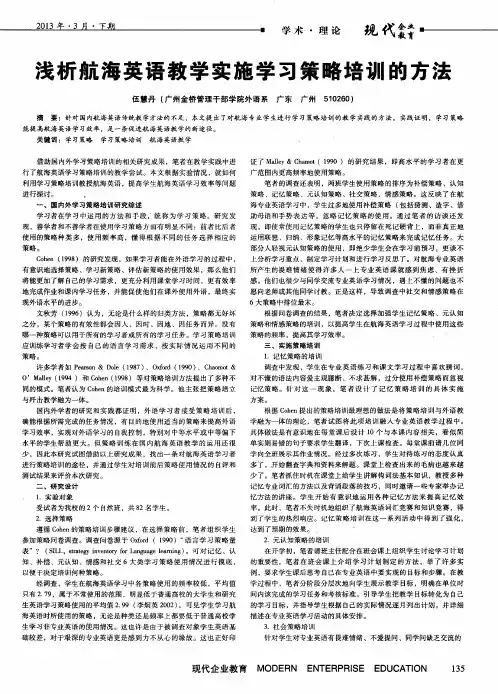
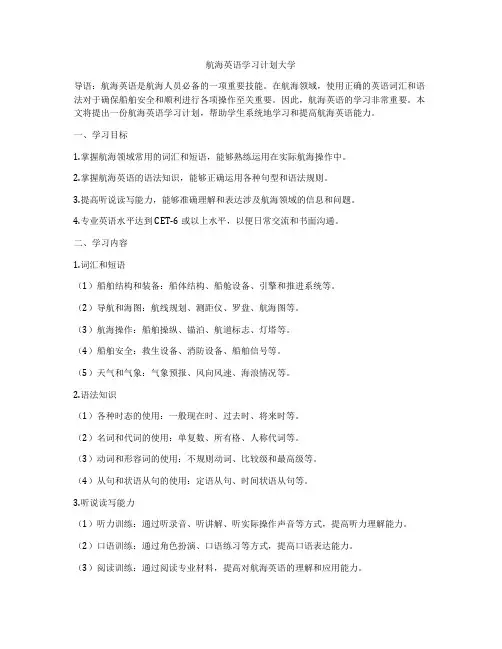
航海英语学习计划大学导语:航海英语是航海人员必备的一项重要技能。
在航海领域,使用正确的英语词汇和语法对于确保船舶安全和顺利进行各项操作至关重要。
因此,航海英语的学习非常重要。
本文将提出一份航海英语学习计划,帮助学生系统地学习和提高航海英语能力。
一、学习目标1.掌握航海领域常用的词汇和短语,能够熟练运用在实际航海操作中。
2.掌握航海英语的语法知识,能够正确运用各种句型和语法规则。
3.提高听说读写能力,能够准确理解和表达涉及航海领域的信息和问题。
4.专业英语水平达到CET-6或以上水平,以便日常交流和书面沟通。
二、学习内容1.词汇和短语(1)船舶结构和装备:船体结构、船舱设备、引擎和推进系统等。
(2)导航和海图:航线规划、测距仪、罗盘、航海图等。
(3)航海操作:船舶操纵、锚泊、航道标志、灯塔等。
(4)船舶安全:救生设备、消防设备、船舶信号等。
(5)天气和气象:气象预报、风向风速、海浪情况等。
2.语法知识(1)各种时态的使用:一般现在时、过去时、将来时等。
(2)名词和代词的使用:单复数、所有格、人称代词等。
(3)动词和形容词的使用:不规则动词、比较级和最高级等。
(4)从句和状语从句的使用:定语从句、时间状语从句等。
3.听说读写能力(1)听力训练:通过听录音、听讲解、听实际操作声音等方式,提高听力理解能力。
(2)口语训练:通过角色扮演、口语练习等方式,提高口语表达能力。
(3)阅读训练:通过阅读专业材料,提高对航海英语的理解和应用能力。
(4)写作训练:通过写作练习,提高书面表达能力。
三、学习方法1.词汇和短语的记忆方法(1)背诵:对重要的词汇和短语进行背诵,以便熟练掌握。
(2)应用:积极参与航海实践,运用学习的词汇和短语进行交流和操作。
2.语法知识的学习方法(1)理解:通过课堂学习和阅读专业书籍,理解和掌握各种语法知识。
(2)练习:通过大量的练习题,加深对语法知识的理解和掌握。
3.听说读写能力的提高方法(1)听力训练:多听航海英语的录音,提高听力理解能力。
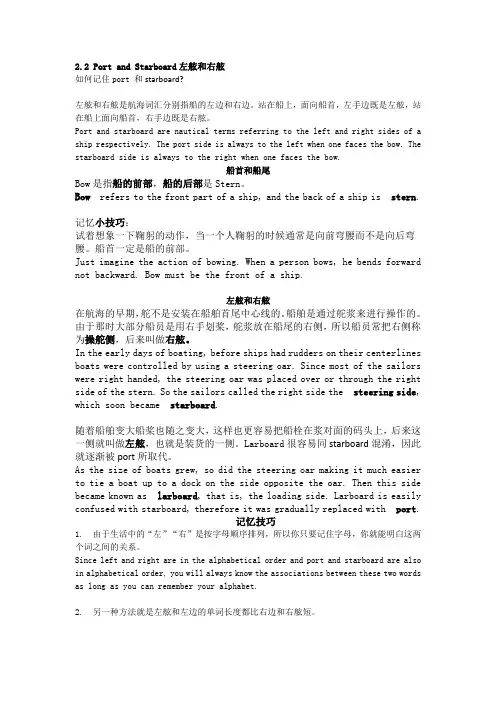
2.2 Port and Starboard左舷和右舷如何记住port 和starboard?左舷和右舷是航海词汇分别指船的左边和右边。
站在船上,面向船首,左手边既是左舷,站在船上面向船首,右手边既是右舷。
Port and starboard are nautical terms referring to the left and right sides of a ship respectively. The port side is always to the left when one faces the bow. The starboard side is always to the right when one faces the bow.船首和船尾Bow是指船的前部,船的后部是Stern。
Bow refers to the front part of a ship, and the back of a ship is stern.记忆小技巧:试着想象一下鞠躬的动作,当一个人鞠躬的时候通常是向前弯腰而不是向后弯腰。
船首一定是船的前部。
Just imagine the action of bowing. When a person bows, he bends forward not backward. Bow must be the front of a ship.左舷和右舷在航海的早期,舵不是安装在船舶首尾中心线的。
船舶是通过舵浆来进行操作的。
由于那时大部分船员是用右手划桨,舵浆放在船尾的右侧,所以船员常把右侧称为操舵侧,后来叫做右舷。
In the early days of boating, before ships had rudders on their centerlines boats were controlled by using a steering oar. Since most of the sailors were right handed, the steering oar was placed over or through the right side of the stern. So the sailors called the right side the steering side, which soon became starboard.随着船舶变大船桨也随之变大,这样也更容易把船栓在浆对面的码头上,后来这一侧就叫做左舷,也就是装货的一侧。

如何学好航海英语IntroductionLearning maritime English is essential for anyone pursuing a career in the maritime industry. Whether you want to become a sailor, a marine engineer, a naval architect, or a maritime lawyer, a good command of maritime English can open up a world of opportunities for you. In this guide, we will discuss some tips and strategies to help you learn maritime English effectively.1. Understand the Importance of Maritime EnglishMaritime English is a specialized form of English that is used in the maritime industry for communication among seafarers, both on board ships and on shore. It includes specific vocabulary, grammar, and pronunciation that are unique to the maritime context. Without a good understanding of maritime English, it can be difficult for seafarers to communicate effectively with each other, with port authorities, and with other stakeholders in the industry. This can lead to misunderstandings, errors, accidents, and even dangerous situations at sea.2. Build Your Maritime VocabularyOne of the first steps in learning maritime English is to build your vocabulary. Start by learning common maritime terms and phrases, such as "port," "starboard," "bow," "stern," "deck," "mast," "hull," "bulkhead," "buoy," "anchor," "crew," "pilot," "galleon," "frigate," "cargo," "port clearance," "weather report," "marine radio," "ship log," "nautical mile," "knot," "draft," "berth," "stowage," "ballast," "bilge," "galley," "mess hall," "helm," "chart," "compass," "masthead light," "mooring line," "buoyancy," "lifeboat," "helicopter pad," "gangway," "gangplank," "fire drill," "man overboard," "Mayday," "SOS," "mayday relay," "pirate attack," "collision," "grounding," "abandon ship," "muster station," "life vest," "immersion suit," "life raft," "search and rescue," "marine pollution," "oil spill," "contingency plan," "pollution control," "hazardous cargo," "damage control," "emergency response," "emergency evacuation," "fire-fighting equipment," "firefighting drill," "fire extinguisher," "fire blanket," "smoke detector," "fire alarm," "fire suppression system," "fire-resistant door," "fireproof bulkhead," "fire hose," "fire hydrant," "fire pump," "fire drill," "evacuation plan," "evacuation route," "evacuation assembly point," "evacuation procedure," "evacuation training," "emergency lighting," "emergency power," "emergency generator," "emergency medical kit," "emergency medical assistance," "medical emergency," "medical evacuation," "medical evacuation plan," "medical evacuation procedure," "medical evacuation team," "medical evacuation helicopter," "stretcher," "first aid," "first aid kit," "first aid training," "first aider," "first responder," "emergency response team," "emergency response plan," "emergency response procedure," "emergency response team," "emergency response training," "emergency response drill," "emergency response exercise," "emergency response coordinator," "emergency response center," "emergency communication," "emergency contact," "emergency notification," "emergency alert," "emergency call,""emergency radio," "emergency telephone," "emergency telephone number," "emergency signal," "emergency light," "emergency power," "emergency generator," "emergency shelter," "emergency rescue," "emergency relief," "emergency recovery," "emergency help," "emergency support," "emergency assistance," "emergency aid," "emergency medical care," "emergency medical treatment," "emergency medical service," "emergency medical team," "emergency medical support," "emergency medical response," "emergency medical system," "emergency medical personnel," "emergency medical equipment," "emergency medical facility," "emergency medical supplies," "emergency medical transport," "emergency medical evacuation," "emergency medical assistance," "emergency medical evacuation plan," "emergency medical evacuation procedure," "emergency medical evacuation team," "emergency medical evacuation helicopter," "emergency medical evacuation service," "emergency medical evacuation support," "emergency medical evacuation response," "emergency medical evacuation system," "emergency medical evacuation readiness," "emergency medical evacuation training," "emergency medical evacuation drill," "emergency medical evacuation exercise," "emergency medical evacuation coordination," "emergency medical evacuation center," "emergency medical evacuation communication," "emergency medical evacuation contact," "emergency medical evacuation notification," "emergency medical evacuation alert," "emergency medical evacuation call," "emergency medical evacuation radio," "emergency medical evacuation telephone," "emergency medical evacuation number," "emergency medical evacuation signal," "emergency medical evacuation light," "emergency medical evacuation power," "emergency medical evacuation generator," "emergency medical evacuation facility," "emergency medical evacuation team," "emergency medical evacuation support," "emergency medical evacuation aid," "emergency medical evacuation service," "emergency medical evacuation response," "emergency medical evacuation system," "emergency medical evacuation coordination," "emergency medical evacuation center," "emergency medical evacuation communication," "emergency medical evacuation contact," "emergency medical evacuation notification," "emergency medical evacuation alert," "emergency medical evacuation call," "emergency medical evacuation radio," "emergency medical evacuation telephone," "emergency medical evacuation number," "emergency medical evacuation signal," "emergency medical evacuation light," "emergency medical evacuation power," "emergency medical evacuation generator," "emergency medical evacuation facility," "emergency medical evacuation supplies," "emergency medical evacuation transport," "emergency medical evacuation shelter," "emergency medical evacuation rescue," "emergency medical evacuation relief," "emergency medical evacuation recovery," "emergency medical evacuation help," "emergency medical evacuation assistance," "emergency medical evacuation care," "emergency medical evacuation treatment," "emergency medical evacuation service," "emergency medical evacuation system," "emergency medical evacuation personnel," "emergency medical evacuation team," "emergency medical evacuation equipment," "emergency medical evacuation facility," "emergency medical evacuation supplies," "emergency medical evacuation transport," "emergency medical evacuation shelter," "emergency medical evacuation rescue," "emergency medical evacuation relief," "emergency medical evacuation recovery," "emergency medical evacuation help,""emergency medical evacuation assistance," "emergency medical evacuation aid," "emergency medical evacuation service," "emergency medical evacuation care," "emergency medical evacuation treatment," "emergency medical evacuation facility," "emergency medical evacuation supplies," "emergency medical evacuation equipment," "emergency medical evacuation transport," "emergency medical evacuation shelter," "emergency medical evacuation rescue," "emergency medical evacuation relief," "emergency medical evacuation recovery," "emergency medical evacuation help," "emergency medical evacuation assistance," "emergency medical evacuation aid," "emergency medical evacuation service," "emergency medical evacuation care," "emergency medical evacuation treatment," "emergency medical evacuation support," "emergency medical evacuation system," "emergency medical evacuation personnel," "emergency medical evacuation team," "emergency medical evacuation equipment," "emergency medical evacuation facility," "emergency medical evacuation facility," "emergency medical evacuation facility," "emergency medical evacuation telecommunic.XtraLayout3. Study Maritime English GrammarIn addition to building your maritime vocabulary, it is also important to study maritime English grammar. Pay attention to the specific grammar rules and structures that are commonly used in maritime communication. This includes understanding how to use verb tenses, pronouns, prepositions, articles, conjunctions, and other parts of speech correctly in the maritime context. For example, learn how to use the passive voice, the imperative mood, and the subjunctive mood in maritime English. Practice writing sentences, paragraphs, and essays in maritime English to improve your grammar skills.4. Practice Speaking Maritime EnglishAnother important aspect of learning maritime English is to practice speaking it. Take every opportunity to speak maritime English with your classmates, teachers, colleagues, and other seafarers. Join a maritime English conversation group or club to practice speaking and listening to maritime English in a supportive environment. Role-play common maritime scenarios, such as communicating with the port authorities, conducting a safety drill, responding to an emergency situation, and giving instructions to the crew. This will help you become more confident and fluent in speaking maritime English.5. Listen to Maritime EnglishIn addition to speaking maritime English, it is also important to listen to it. Watch maritime English videos, listen to maritime English podcasts, and attend maritime English conferences, seminars, and workshops to improve your listening skills. Pay attention to the pronunciation, intonation, accent, and rhythm of maritime English speakers. Practice listening to different accents and dialects of maritime English to become more familiar with the variety of ways that maritime English is spoken around the world.6. Read Maritime EnglishReading is another effective way to improve your maritime English skills. Read maritime English books, articles, journals, magazines, and websites to expand your knowledge of the maritime industry and to learn more maritime English vocabulary and grammar. Make a habit of reading maritime English materials on a regular basis to stay informed about the latest developments in the maritime industry and to improve your reading comprehension skills.7. Write in Maritime EnglishFinally, practice writing in maritime English to enhance your writing skills. Keep a maritime English journal, write maritime English essays, reports, emails, letters, memos, and other written documents to improve your spelling, punctuation, grammar, vocabulary, and style in maritime English. Review your writing and ask for feedback from your teachers, tutors, classmates, colleagues, and other seafarers to help you identify areas for improvement and to make corrections to your writing.ConclusionIn conclusion, learning maritime English is essential for anyone pursuing a career in the maritime industry. By building your maritime vocabulary, studying maritime grammar, practicing speaking maritime English, listening to maritime English, reading maritime English, and writing in maritime English, you can improve your communication skills and succeed in the maritime industry. Remember to stay motivated, dedicated, and persistent in your efforts to learn maritime English, and you will soon become a fluent and confident maritime English speaker. Good luck!。
航海英语学习计划小学第一部分:介绍航海英语是航海人员必备的语言技能,它不仅在国际航海交流中起到重要的作用,而且也是航海人员在国际海域中进行航行和应对突发情况时必不可少的工具。
因此,学习航海英语对于航海人员来说至关重要。
本文将为小学生提供一份航海英语学习计划,帮助他们系统地学习航海英语,为将来成为一名合格的航海人员做好准备。
第二部分:学习目标1. 掌握关于航海的基本知识和专业术语;2. 能够熟练运用航海英语进行简单的口语交流;3. 能够理解和使用航海英语的常见词汇和短语;4. 了解航海英语在实际航行中的应用。
第三部分:学习内容1. 日常会话- 介绍自己和他人- 问候和道别- 询问信息和指示- 感谢和道歉- 紧急情况下的交流2. 专业术语- 船舶部件名称- 航行环境相关术语- 海事安全和救生设备名称- 航行规则和标志3. 常见词汇和短语- 天气和海况相关词汇- 航行中的指示和口令- 导航和航行工具名称- 探测和监测设备名称第四部分:学习方法1. 课堂学习- 跟着老师学习航海英语的基础知识和基本技能;- 利用多媒体工具,如视频、图表等,辅助学习航海英语的相关内容;- 通过课堂练习和词汇记忆,提高学生的语言表达能力。
2. 实践演练- 安排模拟航海实践,让学生在真实环境中应用航海英语;- 利用角色扮演和小组合作的方式,进行航海英语口语对话和指令练习;- 在室内或室外场地进行模拟航海任务,让学生运用航海英语进行交流和指挥。
3. 多媒体学习- 利用航海英语的相关音频和视频资源,帮助学生提高对航海英语的听力和口语技能;- 利用航海英语的相关图表和图片资料,帮助学生更直观地理解和记忆航海英语的专业术语和常见词汇。
第五部分:学习步骤1. 学习基础知识在课堂上,学生将学习有关航海英语的基础知识,包括日常会话、专业术语和常见词汇和短语等内容。
2. 实践演练在课外时间,学生将参与模拟航海实践和实际航行任务,运用航海英语进行口语交流和指挥。
轮机英语语法的特点及学习技巧【摘要】轮机英语是航海类专业院校中轮机工程专业学生的必修科目,也是他们参加海事局组织的海船船员适任考试的考试科目之一,是一门很重要的课程,但同时,也是他们学习的难点之一。
大多数学习者反应,轮机英语词汇多,语法结构复杂,学习比较吃力。
因此本文从几个方面分析了轮机英语语法方面的特点,以及学习技巧,希望对学习者有所帮助。
【关键词】轮机英语语法特点学习技巧【中图分类号】 G642 【文献标识码】 A【文章编号】 1006-9682(2009)08-0076-02【Abstarct】English of Marine Engineering is one of the required courses for those who study in Marine Colleges, and it is also one of the tested subjects when they take part in the Competency Test for Marine Certificate. It is a very difficult subject as well as it is an important one. Most students said that it contains too many technical terms and its grammar is complicated. In order to help students to learn the course better, this paper analyzes the peculiarities of its grammar and gives some methods on how to learn the course.【Key words】English of Marine Engineering Grammar peculiarities Learning skills加入世贸组织后,随着日益加快的全球经济一体化进程,中国海员劳务输出业务发展迅速。
船舶英语的学习方法与技巧船舶英语的学习方法与技巧船舶英语的学习方法与技巧一、如何避免英语学习中的10个误区语法当先:说话、写作之前先想语法,惟恐语法有错,这是学校死板的英语教学给学生留下的最严重的后遗症之一。
心理恐惧:听不懂更不敢说话,读不快也不敢写,惟恐语法有错误导致心理上的畏惧,认为英语是高深莫测的学问,认为英语老师的思维方式才是唯一正确的思路,培养了许多考试高分而真正运用英语低能的学生。
学无致用:学习英语不是为了运用和表达,而是为了考试和过关,于是动机走偏,结果是学得越多,丢得越多;没有把英语变成自己表达自己、与人交流的真正工具,事倍功半,浪费自己的时间和金钱。
落后陈旧:学了不少古董英语。
任何语言都是“活”的语言,在不断丰富,不断进步,从这个意义上说,学习陈旧的语言毫无新鲜感不说,基本无处可用。
急用乱医:不少人在急用英语的情形下,只好囫囵吞枣,有病乱投医,不管学校学习方法是否适合自己,先上再说,选择缺乏理性分析与思考,效果也就可见能有多好?语音不规范:语音非常“中国”是不少英语学习者的特点,原因是听的国际化的发音太少,中国的英语老师中发音语感好的实在有限,所以与其等待他们提高,不如跨越他们(在语音方面)多向母语为英语的人士学习。
用法不入流:不鲜活、不入时、不风趣幽默的语言就不是我们要学的语言,不入流、不分场合的语言学了也无用武之处!盲目崇拜教学单位:这些教学单位也许有很长历史,也有经验丰富的授课老师,但是也有他们的局限性,如观念陈旧、方法陈旧。
幻想一蹴而就:很多人幻想速成英语高手,也许是学得太久,收效太不成正比,所以有这样幻想倾向的人就越多,幻想的程度就越深,幻想的花样也越层出不穷。
期望高学费提高学习效果:外因通过内因发生作用,学习语言也不例外。
现实中不少人不想通过艰辛的付出就想学好语言,结果希望越大,失望越大。
现代英语提倡“教人正确的学习方法”比“教学内容”更重要。
“速成”往往“不成”,也不赞成学习语言要“面壁十年”、“苦学傻练”,而提出要找到最适合自己针对以往不足的训练。
《航海英语听力与会话》课程学习指南一、适用对象本课程适用高职院校航海类专业三年全日制学生,也适用海船驾驶员人员集中培训学习或自主学习。
二、培养目标本课程是为适应STCW78/10公约和国家海事局2011年《中华人民共和国海船船员适任证书考试和发证规则》以及国家海事局2012年《中华人民共和国海船船员适任考试大纲》而开设的旨在适应培养符合国际航运业需要的创造型、复合型、外向型航海类高级人才的主干专业课程之一。
具体来说,通过本课程的系统学习和模拟训练,使学习者掌握一定的航海专业词汇、船舶操纵口令和专业操作用语,做到能用专业英语进行工作和生活方面的交流。
总体讲,本课程开设的目的是着重培养学习者的英语听说能力或交际能力。
三、学习基础要求本课程的开设应在学习者(学员)掌握了一定的语音基础、词汇和语法的前提下并具有一定的听力和会话基础以及自主学习能力。
比较理想的英语理论基础是学习者参加了一学期的大学英语课程的学习或高职高专英语B级课程考试的学生,也适用于想提高航海英语听力与会话水平的广大国际海员。
四、学习指南4.1学习方法指南本课程设计采用模块化教学法,每个模块中包含了数个与主题相关的单元。
学习者可以根据各自的专业英语知识基础进行系统学习或进行选择性学习。
对一般的学习者说,推荐首先熟悉课程标准和电子教材确定将要进行的学习顺序和安排,在此基础上,通过观看视频教学课件进一步熟悉教学模块或教学单元的内容。
在学习过程中,对重点、难点知识可以进行视频回放,强化对知识内容的理解。
必要时学习者可以通过网络与教师开展问答互动,或表达学习感受。
在完成以上学习活动以后,学习者可以通过习题作业或试题测试检验自己的学习效果。
教师也可通过网络开展习题或试题作业的布置,在学习者完成后予以评价。
此外,学习者还可通过课程网站提供的广泛的媒体素材资源和课程拓展资源对本课程的教学模块或教学单元作全方位的学习了解。
此外,学习者也可通过知识点或技能点借助丰富的课程资源有目地选择所需的学习内容。
浅析航海英语的课程性质与学习技巧作者:白璐来源:《中国民族博览》2018年第12期【摘要】文章阐述了航海英语的课程性质,它是航海知识和英语知识的结合,既有航海专业知识的内容阐述,又遵循英语语言的学习规律。
学习航海英语需要掌握一定的学习技巧,应注意积累专业词汇,夯实专业知识,理论与实践相结合,勤学苦练,进行适当的阅读和拓展,会达到事半功倍的学习效果。
【关键词】航海英语;课程性质;学习技巧【中图分类号】H319 【文献标识码】A航海英语是远洋海船船员适任考试科目,对在校航海专业学生来说意义重大。
航海英语是远洋海船船员的主要工作语言,对上船工作的船员来说是硬性要求。
尽管航海英语这么重要,但在学习过程中,很多学员或望而生畏,或事倍功半。
归根结底,是没有认清航海英语课程的实质以及没有掌握航海英语的学习技巧。
单凭对英语的直观感受和对庞杂专业知识的畏难情绪学习航海英语,效果一般不理想。
航海英语是全新的科目,它并不等同于普通英语,也并未涉及过深过难的专业知识。
可以说,只要学生有端正的学习态度,认真的学习精神,对科目有清醒的认识和理解,以及正确有效的学习方法,是完全可以学好航海英语的。
一、航海英语的课程性质航海英语是航海知识和英语知识的结合。
一方面,航海英语的主体内容完全遵循航海专业知识的阐述,没有产生新的知识点和概念;另一方面,航海英语完全符合英语语言规范,没有打破英语知识架构。
也就是说,学过英语的大学生具备了学习航海英语的语言基础。
大学期间,随着航海专业课学习的推进,逐步将专业的内容转化为英语去表达,久而久之,学生就掌握了航海英语。
因此,航海英语被认为是航海专业知识的英语版。
(一)英语基础英语基础对航海英语的学习有一定的影响,但并不是决定性的。
航海英语对英语语言能力的考核从范围上是收窄了的。
例如,航海英语的语法项目重点考察被动语态、定语从句和非谓语动词三项,相对于英语考核,内容比较集中。
因此,学生反复练习这三项内容,会在理解能力和分析能力上有很大的提高。
大学英语教材航海类专业随着全球化的发展和航海业的兴起,航海类专业在大学中受到越来越多学生的关注和选择。
为了满足学生对此类专业知识的需求,大学英语教材中也逐渐增加了航海类专业的相关内容。
本文将重点介绍大学英语教材中航海类专业所涉及的主要内容和学习方法。
一、船舶概述在航海类专业的英语教材中,首先会介绍船舶的概述。
这部分内容包括船舶的种类、结构、组成部分以及相关的术语和定义。
学习者需要掌握各种类型的船舶,如货船、客船、油船等,并且了解它们的构造和各部分的名称。
此外,学习者还需要熟悉一些常用的航海术语和定义,以便在实际航行中进行交流和理解。
二、航海导航航海导航是航海类专业中的重要内容之一。
在大学英语教材中,会介绍航海导航所需的基本知识和技能。
学习者需要了解星座导航、无线电导航和卫星导航等不同的导航方法,并学会使用相关的仪器设备进行导航操作。
此外,还需要学习如何读懂海图和航海图表,以及如何进行航行计划和航线规划。
三、海洋气象了解海洋气象对于航海类专业的学习者而言十分重要。
在大学英语教材中,会介绍海洋气象的基本概念,包括气象要素、气象系统和气象预报等内容。
学习者需要学会解读气象图、掌握气象预报的方法和技巧,以便在航行中合理安排航线和避免恶劣天气的影响。
四、海上安全海上安全是航海类专业中至关重要的一部分。
大学英语教材中会着重介绍海上事故的原因、预防和救援措施等内容。
学习者需要了解各种类型的事故,如碰撞、火灾、沉船等,并学会采取相应的安全措施。
此外,还需要学习船舶逃生、急救和求生等基本技能,以保障船员和乘客的生命安全。
五、国际海事法律在大学英语教材中,对于航海类专业的学习者而言,理解国际海事法律是不可或缺的。
学习者需要了解国际海事组织和国际海事公约,掌握国际海事法规的基本原则和规定。
此外,还需要熟悉船舶登记、船舶搜索与救助以及海上环境保护等相关的法律和政策。
总结起来,大学英语教材中航海类专业的内容十分丰富。
学习者需要通过掌握船舶概述、航海导航、海洋气象、海上安全和国际海事法律等知识,为日后的船舶操作和管理提供坚实的基础。
航海英语学习方法介绍
很多刚上学的海员,别是甲类高级海员都比较怕学习航海英语,其实航海英语和平时英语一样,并不是那么可怕,关键在于学习方法和恒心,下面为高级海员学子介绍几种学习英语的方法。
用英美人的方式思维学英语,想说得溜必须习惯Think in English(用英语思维)。
譬如,美国人喜欢从自我出发来安排描述的顺序。
最明显的例子莫过于中英文书信地址的不同写法:前者按区域由大到小锁定某一地点,后者则采取了截然相反的方式。
又如在汉语里我们说:缺了一条腿。
英语中相应的表达却是:with only one leg(只有一条腿),一个强调有一个强调无,思维习惯上的差异十分明显。
处理好母
语与英语之间的关系,可以在两种语言的相互比较中加深对英语思维的认识,获益匪浅;
纠正英语角英语症为练习口语,许多人喜欢去自发的英语角练对话,却在不知不觉中患上了英语角英语症流利,但错误较多。
流利来自于练习,错误源于翻译。
这表明你的口语是在没有母语环境下反复练习的结果,许多用词造句直接从中文翻译过去,不少用法也不合规律。
纠正良方:学会仔细倾听,尤其是一些表达不够精练的时候,很多人的问题不在于词汇量不够,而是在于不知道如何使用。
越是地道的口语,越是简单;
正确运用体态语言掌握肢体评议的技巧。
以6 个字母代表:Ssmile 微笑是友好,愿意和别人交往的标记。
Oopen,开放的姿势,是一种欢迎别人和你交谈的姿势Fforward lean,在和别人讲话时,身子要稍稍前倾Ttouch,和别人相遇时,用热情而有力的握手表示友好。
Eeye contact,眼睛是传递非语言信息的最有效渠道。
Nnod 常用点头来表示我在认真听你说或同意你的看法;。